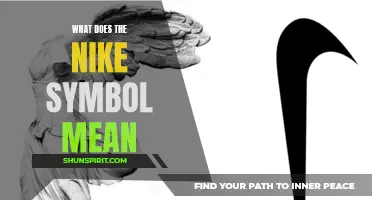
The moon star symbol, also known as the crescent star symbol, has been a powerful and captivating image throughout history. This symbol holds various meanings and significance in different cultures and religions worldwide, symbolizing everything from divinity and spirituality to femininity and guidance. Join me on a journey through time and culture as we explore the captivating symbolism behind the moon star symbol.
What You'll Learn
- What is the symbolic meaning of the moon and star symbol?
- How has the meaning of the moon and star symbol changed throughout history?
- Is there a specific cultural or religious significance to the moon and star symbol?
- What are some common interpretations of the moon and star symbol in different countries or regions?
- Can the moon and star symbol be found in modern-day art and fashion?

What is the symbolic meaning of the moon and star symbol?
The moon and star symbol has long been associated with various cultures and has acquired different symbolic meanings over time. This symbol has been used in different religious, cultural, and historical contexts, each with their own interpretation and significance.
In many ancient cultures, including those of Mesopotamia and ancient Egypt, the moon and star symbol was associated with deities related to celestial bodies. The moon was seen as a symbol of femininity, while the star represented masculinity. Together, they symbolized the union of opposites and the harmony between masculine and feminine forces.
In Islamic culture, the moon and star symbol holds religious significance. It is widely recognized as the symbol of Islam and has been used to represent the religion for centuries. The crescent moon and star together are often seen on flags, mosques, and other Islamic symbols. The crescent moon is believed to symbolize progress, as it reflects the cycles of the lunar month and the passage of time.
In astrology, the moon represents emotions, intuition, and the subconscious mind. It is associated with the feminine energy and the nurturing aspects of one's personality. The star, on the other hand, symbolizes guidance, inspiration, and aspiration. Together, the moon and star represent the journey towards self-discovery and inner wisdom.
The moon and star symbol also holds spiritual and mystical connotations. Some believe that the symbol represents the union of heaven and earth, the divine and mortal. It is seen as a reminder of the interconnectedness of all things and the divine forces that govern the universe.
In modern times, the moon and star symbol has become a popular decorative motif and is commonly used in jewelry, clothing, and home decor. Many people are drawn to its aesthetic appeal and the sense of mystery and enchantment it evokes.
Overall, the symbolic meaning of the moon and star symbol varies across cultures and contexts. It is often associated with femininity, intuition, and the divine, representing the harmony between opposites and the journey towards self-realization. Whether used in a religious, cultural, or personal context, the moon and star symbol continues to captivate and inspire individuals around the world.
The Symbolic Significance of June: Exploring the Meaning Behind the Month
You may want to see also

How has the meaning of the moon and star symbol changed throughout history?
The moon and star symbol is one of the most ancient and widely recognized symbols in human history. It has been used by various cultures and civilizations throughout time in different contexts and with varying meanings. This symbol has evolved and changed its significance over the centuries, often reflecting the beliefs, ideologies, and experiences of the people who used it.
One of the earliest recorded uses of the moon and star symbol can be traced back to ancient Mesopotamia, specifically the civilization of Sumer. In Sumerian mythology, the moon was associated with the god Nanna, while the star represented the goddess Inanna. They were considered powerful deities, with the moon representing fertility, protection, and the afterlife, and the star symbolizing divine guidance and messages from the gods. This interpretation highlights the celestial aspects of the symbol and its connection to the spiritual realm.
As time progressed, the moon and star symbol found its way into the emblem of various empires and cultures. One significant example of this is the Ottoman Empire, where the crescent moon and star became a prominent symbol. This emblem primarily represented the empire's Islamic identity, as the moon and star have important connotations in Islamic culture. The crescent moon symbolizes the start of the Islamic month and often appears on flags and other Islamic artifacts to represent the faith. The star represents enlightenment and guidance, symbolizing the path to righteousness and truth.
In modern times, the meaning of the moon and star symbol has evolved even further. It has been adopted by various organizations and movements to represent different causes and ideologies. For example, it is often used to symbolize feminism, reflecting the idea of female empowerment and unity. The moon is associated with the goddess and the cyclical nature of femininity, while the star represents hope, strength, and determination.
Furthermore, the moon and star symbol has been utilized as a representation of the LGBTQ+ community. The rainbow-colored moon and star have become a recognized symbol of inclusivity, love, and diversity, reflecting the belief in the beauty of difference and acceptance.
In summary, the meaning of the moon and star symbol has changed throughout history, adapting to the beliefs and values of different cultures. From its origins in ancient Mesopotamia, through its association with Islamic culture, to its modern-day representations in feminist and LGBTQ+ movements, the moon and star symbol continues to inspire and evolve, representing a wide range of meanings and ideologies.
Exploring the Intriguing Symbolism Behind the Berserker Symbol
You may want to see also

Is there a specific cultural or religious significance to the moon and star symbol?
The moon and star symbol has a rich cultural and religious significance in various societies across the world. In many ancient civilizations, the moon and star were seen as divine entities, and their symbolization represented a connection to the heavens.
One of the earliest known depictions of the moon and star symbol can be found in ancient Mesopotamia, specifically in Sumeria. The Sumerians worshipped the moon god Nanna, also known as Sin, and associated him with the crescent moon. The moon and star symbol was used on seals, pottery, and other artifacts as a representation of this deity and his power over the night sky.
Similarly, in ancient Egypt, the moon and star symbolized the god Thoth and the goddess Isis, respectively. Thoth was the god of wisdom and knowledge, and Isis was revered as the mother goddess and protector of the sky. The moon and star symbol was often associated with these deities and their divine influence.
Moving eastward to ancient China, the moon and star symbol held similar significance. In Chinese mythology, the moon goddess Chang'e resided on the moon, and her symbol was a rabbit pounding medicine in a mortar under a cassia tree. This imagery represented longevity and the cycle of life, with the moon symbolizing immortality and divine intervention.
In Islamic culture, the moon and star symbol has come to be associated with the religion itself. The star represents both the divine light of Allah and guidance, while the crescent moon is often seen as a symbol of the beginning and end of the Islamic lunar month. It is important to note that the moon and star symbol is not an official symbol of Islam, but it has become widely recognized and used to denote Islamic identity.
Throughout history, the moon and star symbol has also been used in various other cultures and religions, including Hinduism, Buddhism, and ancient Native American tribes. In these contexts, the symbol often represents celestial bodies and their connection to the spiritual realm.
In conclusion, the moon and star symbol holds significant cultural and religious value in many societies around the world. From ancient Mesopotamia to modern Islamic culture, this symbol has represented divine power, guidance, and celestial entities. The meaning behind the symbol may vary depending on the specific culture or religion, but its importance and recognition have endured throughout history.
Exploring the Deeper Meaning Behind the Symbol of Gratitude
You may want to see also

What are some common interpretations of the moon and star symbol in different countries or regions?
The moon and star symbol is one of the oldest and most widely recognized symbols in the world. It can be found in various forms and interpretations across different countries and regions. The symbol carries different meanings and symbolism depending on the cultural background and historical context. Here are some common interpretations of the moon and star symbol in different countries:
- Islam: In Islam, the moon and star symbol is widely associated with the religion and is prominently featured on the flags of several Muslim-majority countries, including Turkey, Algeria, Pakistan, and Malaysia. The symbol represents the importance of the Islamic calendar, which is lunar-based, with the crescent moon marking the beginning of each month. It is also a symbol of guidance and enlightenment in Islam.
- Turkey: The moon and star symbol holds significant historical and cultural importance in Turkey. It is often associated with the Turkic people who were nomadic in nature and relied on celestial navigation. The symbol represents freedom, light, and guidance. It is also believed to have been used by the ancient Turkic tribes as a talisman for protection against evil spirits.
- India: In Indian culture, the moon and star symbol is often associated with deities and mythology. The moon is considered a symbol of beauty, purity, and immortality, while the star represents divine light and guidance. The moon and star symbolizes the eternal cosmic balance between light and darkness.
- Christianity: Although not as widely recognized as other interpretations, the moon and star symbol has some significance in Christianity. It is often associated with the Virgin Mary, who is sometimes depicted with a crescent moon beneath her feet. The image represents her being crowned as the Queen of Heaven and is also seen as a symbol of the everlasting triumph of light over darkness.
- Ancient Mesopotamia: In ancient Mesopotamia, the moon and star symbol was associated with the moon god Sin. The crescent moon represented the celestial power of the moon, while the star symbolized other deities or celestial bodies. The symbol was widely used on seals, jewelry, and sculptures during the ancient Sumerian, Babylonian, and Assyrian civilizations.
These are just a few examples of the various interpretations of the moon and star symbol. The symbol's meaning can vary greatly depending on the historical, cultural, and religious context in which it is used. It continues to be recognized and respected across different countries and regions, serving as a reminder of the deep connection between humans and the cosmos.
Decoding the Meaning Behind Biker Symbols: Unveiling the Secret Language of Motorcycle Clubs
You may want to see also

Can the moon and star symbol be found in modern-day art and fashion?
The moon and star symbol has been a powerful and popular motif throughout history, and it continues to hold a strong presence in modern-day art and fashion. This symbol, often associated with celestial themes, has a rich history across various cultures and is frequently used to signify spirituality, mysticism, and a connection to the universe.
In art, the moon and star symbol can be found in various forms and mediums. Many contemporary artists incorporate this symbol into their work, using it to convey a sense of awe and wonder. For example, some artists create intricate paintings or sculptures featuring the moon and star symbol, often combined with other celestial elements or natural landscapes. These artworks often aim to capture the beauty and mystery of the night sky, offering viewers a sense of transcendence and introspection.
Fashion has also embraced the moon and star symbol, with designers incorporating it into their designs in various ways. This symbol can be seen on clothing, accessories, and even in jewelry collections. The moon and star motif lends itself well to the world of fashion, as it adds an element of whimsy, enchantment, and ethereal beauty to a garment or accessory. Many fashion brands have successfully incorporated this symbol into their designs, creating a unique aesthetic that resonates with a wide range of people.
In addition to its aesthetic appeal, the moon and star symbol holds deep symbolic meaning for many individuals. It is often associated with femininity, as it is commonly believed to represent the divine feminine and the cyclical nature of life. For some, the moon and star symbol also represents guidance and protection, serving as a reminder to always follow one's intuition and inner voice.
Furthermore, the moon and star symbol has become associated with various subcultures and movements, such as the New Age and spiritual communities. It is often seen as a representation of a connection to the cosmos and a reminder of our place in the universe. This symbol has also been adopted by some pagan and Wiccan traditions, where it is used to symbolize the Goddess, as well as the cycles of the moon and the changing seasons.
Overall, the moon and star symbol continues to have a lasting impact on modern-day art and fashion. Its timeless appeal and rich symbolism make it a powerful motif that resonates with people from all walks of life. Whether used in a contemporary artwork or as a feature in a fashionable garment, this symbol adds an element of magic and enchantment, inviting viewers and wearers to embark on a journey to explore and connect with the mysteries of the universe.
In conclusion, the moon and star symbol is widely found in modern-day art and fashion. It serves as a powerful motif that conveys spirituality, mysticism, and a connection to the universe. Artists and designers continue to incorporate this symbol into their work, offering viewers and wearers a sense of awe, wonder, and enchantment. The moon and star symbol not only adds aesthetic appeal but also holds deep symbolic meaning, making it a timeless and significant element in contemporary creative expression.
The Mystical Meanings Behind the Handprint Symbol
You may want to see also
Frequently asked questions
The moon star symbol, also known as the pentacle, is a sacred symbol that holds different meanings across various cultures and religions. In general, it represents the combination of the divine masculine and feminine energies, symbolizing balance and harmony.
Yes, the moon star symbol is commonly associated with witchcraft and paganism. It is often used as a symbol of protection, magic, and spiritual connection in modern witchcraft practices.
Yes, the interpretation of the moon star symbol can vary greatly depending on the cultural and religious context. For example, in Islam, the crescent moon and star are religious symbols representing the Muslim faith and community.
In addition to its associations with balance, witchcraft, and religion, the moon star symbol is often seen as a representation of the five elements in pagan belief systems. These elements include earth, air, fire, water, and spirit, with the pentacle symbolizing their unity and interconnectedness.







